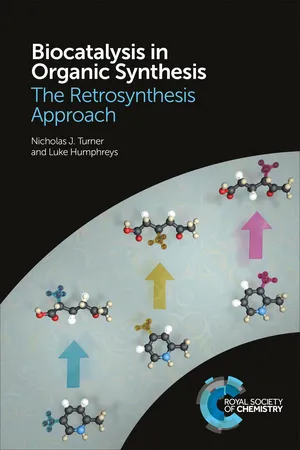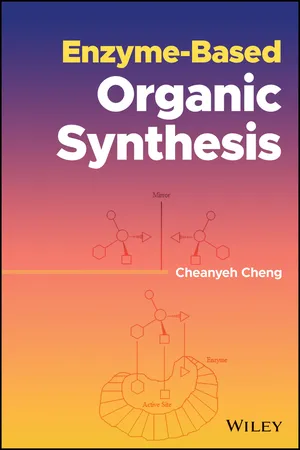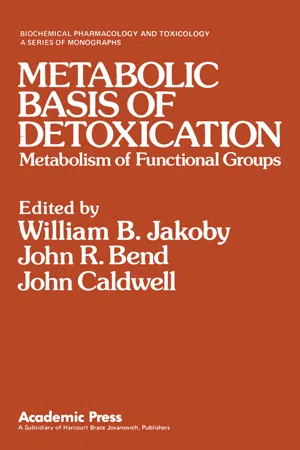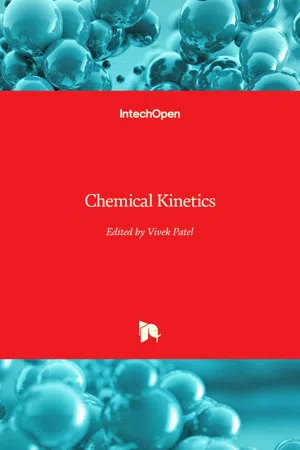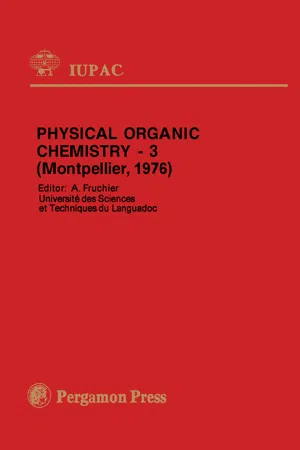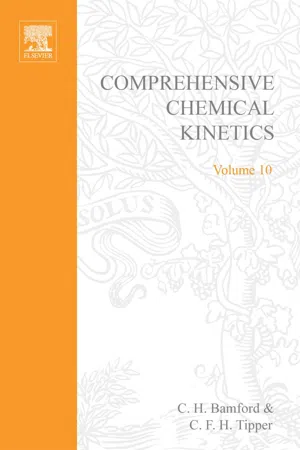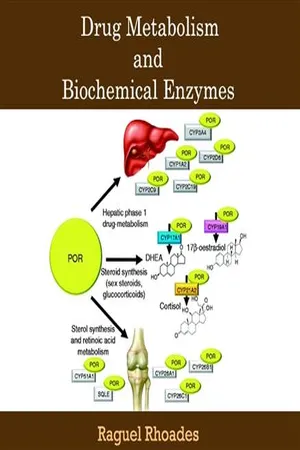Chemistry
Acid Catalysed Hydrolysis of Ester
The acid-catalyzed hydrolysis of ester is a chemical reaction in which an ester molecule reacts with water in the presence of an acid catalyst to produce a carboxylic acid and an alcohol. The acid catalyst helps to facilitate the reaction by donating a proton to the ester molecule, making it more susceptible to nucleophilic attack by water. This process is commonly used in organic synthesis and industrial processes.
Written by Perlego with AI-assistance
Related key terms
1 of 5
12 Key excerpts on "Acid Catalysed Hydrolysis of Ester"
- eBook - ePub
Biocatalysis in Organic Synthesis
The Retrosynthesis Approach
- Nicholas J Turner, Luke Humphreys(Authors)
- 2018(Publication Date)
- Royal Society of Chemistry(Publisher)
Figure 3.2 , if we start with an ester, we can use a hydrolase and water to break the C–O ester bond to give a carboxylic acid and an alcohol.Figure 3.2 General transformation catalysed by hydrolases.This is exactly the same as if we had hydrolysed the ester chemically under either acidic or basic conditions. For acidic hydrolysis, we use a dilute acid such as hydrochloric acid to catalyse the reaction, whereas for basic hydrolysis we use hydroxide ions such as sodium hydroxide. These methods are easy to carry out, but we must be careful that the conditions of the hydrolysis reaction are compatible with the rest of the functional groups in the molecule, especially if we need to heat the reaction or use a strong acid or base. By comparison, enzyme-catalysed hydrolysis occurs under much milder conditions.There is also another advantage to carrying out a hydrolysis reaction using an enzyme: stereoselectivity. If we use a chiral ester as a substrate for the hydrolysis reaction, then the hydrolase enzyme will catalyse the reaction of one enantiomer of the ester faster than the other. This is because the enzyme itself is chiral and so will interact with enantiomers at different rates. As shown in Figure 3.3 , if we take a chiral ester that is a racemic mixture, then the hydrolase enzyme will hydrolyse one ester at a much faster rate, resulting in kinetic resolution.Figure 3.3 Kinetic resolution of an epoxide substrate catalysed by a hydrolase.In this particular example, we are interested in the chiral epoxide that is in the alcohol part of the ester that was hydrolysed. Instead of a racemic mixture of epoxides (which would be difficult to separate), at the end of the reaction we now have an ester and an alcohol, which we can separate easily.As we have already mentioned, both lipases and esterases will catalyse the hydrolysis of esters. However, when the ester is chiral, the two classes of enzymes prefer different substrates. As shown in Figure 3.4 - Janos Fendler(Author)
- 2012(Publication Date)
- Academic Press(Publisher)
Chapter 5 Micellar Catalysis of Hydrolyses, Solvolyses, and Aminolyses A. Carboxylic Esters The hydrolysis and solvolysis of esters can occur through general and specific acid-catalyzed, pH-independent, and general and specific base-catalyzed mechanisms. These reactions can be classified further according to the type of bond fission and the molecularity of the rate determining step. It is important to realize, however, that there are borderline cases in which classification of the molecularity of the reaction is merely a matter of its academic definition. Consequently, it is preferable to consider only the degree and type of solvent participation in the rate determining step. The specific mechanisms involved in carboxylic ester hydrolysis and solvolysis are dis-cussed in numerous texts and reviews (Bell, 1941, 1959; Gould, 1959; Bender, 1960, 1971; Hine, 1962; Bruice and Benkovic, 1966; Ingold, 1969; Jencks, 1969). Of the mechanisms of carboxylic ester hydrolysis, that for the base-catalyzed reaction is the best understood. It generally proceeds by bimolecular attack of hydroxide ion on the carbonyl group forming a tetrahedral inter-mediate followed by elimination with acyl oxygen fission: Ο O N Ο II w 1^ II R — C — O R / + O H , R — C — O R ' • R — C — O H + H O R ' (5.1) I u O H Due to the relative simplicity of carboxylic ester hydrolysis, in general, and that of base-catalyzed ester hydrolysis, in particular, with respect to enzymatic processes, these reactions have served well as model systems in investigations of micellar effects on reaction rates and activation parameters. In addition, the prevalence in biological systems of carboxylic ester hydrolyses catalyzed 104 A. Carboxylic Esters 105 by nucleophiles and by enzymes renders the investigation of micelle catalyzed ester hydrolyses of obvious importance.- eBook - PDF
- Cheanyeh Cheng(Author)
- 2022(Publication Date)
- Wiley(Publisher)
Enzyme-Based Organic Synthesis , First Edition. Cheanyeh Cheng. © 2022 John Wiley & Sons, Inc. Published 2022 by John Wiley & Sons, Inc. 83 4.1 Hydrolysis of Ester Bond 4.1.1 Ester Hydrolysis with Esterases Esterases (E.C. 3.1.1.1, carboxyl ester hydrolases) are one of the large versatile enzyme groups of hydrolases. They are interested in synthetic chemistry for their ability to catalyze the cleavage and formation of ester bonds. They have been described widely existing in animals, plants, and microorganisms as intra- or extracellular proteins. They have shown many advantages in organic synthesis such as a wide substrate tolerance, high regio- and stereospecificity, not requiring cofactors, and exceptionally robust catalysts of being able to act in the presence of organic solvents. Due to these reasons they have been included in the catalysts with the highest number of indus-trial applications and used for the production of optically pure fine chemicals in the areas of food and drinks, textile and leather, paper, and pharmaceuticals [1–3]. The three-dimensional structure of esterases belongs to the α / β -hydrolase superfamily, that is, a definite order of α -helices and β -sheets, and has a conserved catalytic triad composed of Ser-Asp-His and located in a highly conserved GXSXG sequence. The mechanism for ester hydrolysis or formation is composed of four steps: (i) the sub-strate is bound to Ser residue yielding a tetrahedral intermediate and stabilized by His and Asp residues, (ii) the alcohol is released and an acyl-complex is formed, (iii) the nucleophilic attack of the acyl-complex by either water in hydrolysis or alcohol or ester in ( trans -)esterification forms again a tetrahedral intermediate, and (iv) the res-olution of the intermediate yields the product (an acid or an ester) and free enzyme [2, 3]. The esterases catalyzed hydrolysis is classified in nonselective and selective transformations and is described separately as the following examples. - eBook - PDF
- Mohammad Niyaz Khan(Author)
- 2006(Publication Date)
- CRC Press(Publisher)
2.1.2 H YDROLYSIS OF E STERS The overall reaction for ester hydrolysis may be described as (2.2) The rates of hydrolysis of esters and related compounds are catalyzed by specific acid and specific base catalysts. Fine details of general mechanisms of specific acid and specific base catalyzed hydrolysis of esters are shown in Scheme 2.3 and Scheme 2.4, respectively. It is apparent from Scheme 2.3 that the presence of catalyst (H 3 O + ) should equally increase the rate hydrolysis of ester (i.e., k f value) and the rate of alkanolysis of acid (i.e., k b value) without affecting the ratio k f /k b (i.e., equilibrium concentrations of ester and acid). However, Scheme 2.4 shows that in the presence of specific base catalyst (HO – ), the net reaction shown by Equation 2.2 loses its reversibility. The hydrolysis product, RCOOH is a stronger acid than the conjugate acid (H 2 O) of the specific base catalyst and, consequently, HO – /R 1 O – reacts irreversibly with product RCOOH to produce a more stable product, RCOO – , under such conditions. Thus, it is obvious to say that a specific base cannot catalyze the rate of reverse reaction, i.e., rate of reaction between RCOOH and R 1 OH of Equation 2.2. O + RCH 2 C CH 2 R 1 H O δ+ H 2 + TS 1 RCH C CH 2 R 1 HO H + H 2 O TS 2 RCH O C – CH 2 R 1 H OH – TS 3 CH 2 R 1 O C RCH H – OH – TS 4 RCOOR H O RCOOH R OH k k f b 1 2 1 + ⎯ → ⎯ ← ⎯ ⎯ + 92 Micellar Catalysis 2.1.3 C LEAVAGE OF P HTHALAMIDE UNDER M ILD A LKALINE P H Product characterization studies on the cleavage of phthalamide and related com-pounds under mild alkaline pH ( ≈ 9) reveal the net reaction, which is expressed by Equation 2.3. - eBook - PDF
Metabolic Basis of Detoxication
Metabolism of Functional Groups
- William B. Jakoby(Author)
- 2012(Publication Date)
- Academic Press(Publisher)
In aqueous solution, base-catalyzed hydrolysis of carboxyl esters and amides is irreversible, because the product bearing the free carboxyl group dissociates rapidly to the carboxylate ion, which is inert to nucleophilic attack by alcohols or amines. The acid-catalyzed hydrolysis of amides is also irreversible, because the released amine is transferred to an ammonium ion. Electronegative substituents on either side of the ester or amide bond acceler-ate base-catalyzed hydrolysis. In contrast, such substituents have little influence on acid-catalyzed hydrolysis (3). Most proteins and many small molecules (e.g., histidine) are potent basic catalysts for the hydrolysis of carboxyl esters. The kinetics of ester hydrolysis by human serum albumin, which have been studied extensively (4), are in full accordance with a base-catalyzed mechanism. How-ever, the action of carboxylesterases seems to be similar to acid-catalyzed ester hydrolysis. This has been shown for an intestinal esterase (5) and is also evident from data on the substrate specificity of liver carboxylesterases (6). Because of the conjugation effect, esters and amides of aromatic carboxylic acids generally are more stable to hydrolysis than are the corresponding deriva-tives of simple aliphatic acids (3). Although it seems possible to predict the stability of an ester or amide to base-catalyzed hydrolysis (e.g., by serum albu-min), the action of the various tissue carboxylesterases is much more difficult to predict. Of the esters that are relatively resistant to base-catalyzed hydrolysis, only those that fit in the active site of a hydrolytic enzyme will be cleaved. Unfortunately, our knowledge about the specificity of such enzymes remains rather limited (6). If enzymes are involved in the metabolism of several xenobiotics, competitive inhibition may become a problem. - eBook - PDF
- Vivek Patel(Author)
- 2012(Publication Date)
- IntechOpen(Publisher)
Many researchers have conducted a number of experiments to study the mechanism and kinetics of esterifications promoted by mineral acids (Cardoso et al., 2008). Summarizing recent research and development, esterification is an additive-eliminate course in the presence of mineral acid catalyst, generally complying with the following four typical and mature mechanisms. 2.1.1 Bimolecular reaction In 1895, Emil Fischer discovered that esters are formed simply by heating a carboxylic acid in alcohol solution containing a small amount of strong acid catalyst (Zhang et al., 1995; Rönnback et al., 1997; Otera & Nishikido, 2009). The following mechanism, which includes five elementary reactions, was proposed: 1. Ketonic oxygen is easy to capture hydrogen ion to form protonated carbonyl substrate. 2. The substrate makes carbon atom of carboxyl possess higher electropositive, which is conducive to the attack of nucleophile (RCOH) to generate a tetrahedral intermediate. 3. Transfer of a proton from one oxygen atom to another yields a second tetrahedral intermediate and converts the OH group into a good leaving group. 4. The acyl-oxygen bond disconnects and one water molecule lost. 5. Loss of a proton gives the ester product. The chemical reaction can be expressed as Figure 1. H 3 O H 3 C C OH OH H 2 O H 3 C C OH OH CH 3 OH H 3 C C OH OH HO CH 3 H 3 C C OH OH 2 O CH 3 H 3 C C OH OCH H 3 C C OH OH 2 O CH 3 H 3 C C O OCH H 3 O H 2 O 1 2 5 H 3 C C O OH Fig. 1. Mechanism of bimolecular reaction Streitwieser explained how the proton transfers specifically in 1985(Streitwieser et al., 1985; Liu et al., 2006; Fei & Zhao, 2009). The above chemical step (3) can be written as Figure 2: Recent Developments on the Mechanism and Kinetics of Esterification Reaction Promoted by Various Catalysts 257 H 3 C C OH OH O CH 3 H 2 O H 3 O H 3 C C OH OH 2 O CH 3 H 2 O H 3 C C OH OH HO CH 3 Fig. - eBook - PDF
Biotransfrmtns Prepartv Organic Chemistry
The Use of Isolated Enzymes and Whole Cell Systems in Synthesis
- H. G. Davies, Ralph Green, D. R. Kelly, Stanley M. Roberts(Authors)
- 2012(Publication Date)
- Academic Press(Publisher)
—2— Hydrolysis and Condensation Reactions In this Section the enzyme catalysed hydrolysis reactions of esters, amides, epoxides and nitriles are reviewed. The formation of esters and amides using enzymes is also discussed. 2.1. CLEAVAGE AND FORMATION OF CARBOXYLIC ACID ESTER BONDS 2.1.1. Esterases and Lipases Of the wide range of esterases available commercially, very few have been widely utilized in organic transformations. The most commonly used ester-ases have been pig liver esterase (E.C. 3.1.1.1), porcine pancreatic lipase (E.C. 3.1.1.3) and -chymotrypsin (E.C. 3.4.21.1); others, such as the lipase from the yeast Candida cylindracea, are gaining popularity. Various micro-organisms have been employed for certain hydrolyses and these are included in the following discussion where they perform similar reactions but in better yield, or where they afford better enantiomeric excesses than the reactions catalysed by isolated, partially purified, esterases or lipases. Generally, esterases and lipases have been used for two basic transform-ations. (i) Cleavage of a racemic ester to afford an optically active ester and an optically active acid. Thus by chemical hydrolysis of the resulting optically active ester both the (R) and the (S) acids may be obtained. This method has been utilized to provide starting materials for elegant syntheses of many natural products. (ii) Removal of the acyl group from a racemic acylate to produce an optically active alcohol. Similarly, the recovered acylate may then be chemically hydrolysed to the chiral alcohol, thereby enabling both optically active alcohols to be available for further synthesis. In addition, pro-chiral diesters have been hydrolysed to give high yields of optically active mono-esters. Increasingly, enzymes are becoming used as 25 26 2. HYDROLYSIS AND CONDENSATION REACTIONS catalysts in esterification and transesterification. - eBook - PDF
Physical Organic Chemistry — 3
Plenary Lectures Presented at the Third IUPAC Conference on Physical Organic Chemistry, Montpellier, France, 6 - 10 September, 1976
- A. Fruchier(Author)
- 2017(Publication Date)
- Pergamon(Publisher)
The plot of the rate against the acid concentration is first concave downwards and rises steeply at higher concentrations. The rise was shown (Ref. 57) to represent the normal A.^2 reaction, (iv) There is a strong negative salt effect as in neutral ester hydrolysis, bur in contrast to the normal acid-catalysed hydrolysis, (v) Added organic solvent components decrease their rate much more than the rate of simple esters, (vi) The kinetic deuterium oxide solvent isotope effect is the opposite to that of other esters, but in accordance with neutral ester hydrolysis. The above-mentioned several similarities of this exceptional acid catalysis with neutral ester hydrolysis suggested a special mechanism with a common intermediate which, in addition to the general acid-catalysed partition to reaction products and starting materials, could also decompose via another path requiring an additional proton. This path was supposed to lead to the same intermediates that lie on the reaction path of the A. r 2 hydrolysis. No con-clusive evidence for this mechanism, which we have also called a general base - specific oxonium ion catalysis, could then be presented. A reaction scheme, represented on the next page, was suggested. Last year, Kurz and Farrar (58), in a very thorough and elegant experi-mental and theoretical study of the hydrolysis of ethyl trichloroacetate, presented very convincing evidence for essentially the same mechanism. The notation A-B.-5 is now proposed for it because of the experimental acid catalysis and of the common intermediate with the B AC 5 reaction. - R.G. Compton, C.H. Bamford, C.F.H. Tipper†(Authors)
- 1972(Publication Date)
- Elsevier Science(Publisher)
(ii) General base catalysis The simplest generalization to emerge from the work described above on References pp. 202-207 194 HYDROLYSIS A N D FORMATION O F ESTERS OF ORGANIC ACIDS nucleophilic catalysis, is that the mechanism is only important when the leav- ing group is not too much more strongly basic than the nucleophile. Accord- ingly, general base catalysis is likely to be involved in reactions where the hydrolysis of esters with poor leaving groups, for example, those of simple aliphatic alcohols, is catalyzed by nucleophiles of low basicity. Such catalysis is observed only for very reactive esters, that is, those with strongly electron- withdrawing substituents in the acyl group. reported that imidazole catalyzes the hydrolysis of dimethyl oxalate. In the light of our present knowledge it would appear that this is a system where general base catalysis would be expected, although recently Vuori and KoskikalWW were unable to detect catalysis of dimethyl oxalate hydrolysis by acetate or phosphate. The first clear demonstration of general base catalysis came with the work of Jencks and C a r r i u o l ~ ~ ~ ~ on the hydrolysis of several ethyl haloacetates. They found that a range of general bases catalyzes the hydrolysis of ethyl dichloroacetate and difluoroacetate (Table 39), and catalysis is also observed with ethyl chloro and trichloroacetate, ethyl oxamide, and protonated glycine ethyl ester. The experimental evidence that these reactions do, in fact, represent general base catalysis, rather than nucleophilic catalysis of hydrolysis, is very strong.- No longer available |Learn more
- (Author)
- 2014(Publication Date)
- University Publications(Publisher)
________________________ WORLD TECHNOLOGIES ________________________ Chapter- 8 Esterase (Hydrolysis) An esterase is a hydrolase enzyme that splits esters into an acid and an alcohol in a chemical reaction with water called hydrolysis. A wide range of different esterases exist that differ in their substrate specificity, their protein structure, and their biological function. EC classification Acetylesterase In enzymology, an acetylesterase (EC 3.1.1.6) is an enzyme that catalyzes the chemical reaction an acetic ester + H 2 O an alcohol + acetate Thus, the two substrates of this enzyme are acetic ester and H 2 O, whereas its two products are alcohol and acetate. This enzyme belongs to the family of hydrolases, specifically those acting on carboxylic ester bonds. The systematic name of this enzyme class is acetic-ester acetylhydrolase . Other names in common use include C-esterase (in animal tissues) , acetic ester hydrolase , chloroesterase , p-nitrophenyl acetate esterase , and Citrus acetylesterase . Structural studies As of late 2007, 3 structures have been solved for this class of enzymes, with PDB accession codes 1BS9, 1G66, and 2AXE. ________________________ WORLD TECHNOLOGIES ________________________ Cholinesterase In biochemistry, cholinesterase is a family of enzymes that catalyze the hydrolysis of the neurotransmitter acetylcholine into choline and acetic acid, a reaction necessary to allow a cholinergic neuron to return to its resting state after activation. Types There are two types: • Acetylcholinesterase (EC 3.1.1.7) (AChE), also known as RBC cholinesterase , erythrocyte cholinesterase , or (most formally) acetylcholine acetylhydrolase , found primarily in the blood and neural synapses. Acetylcholinesterase exists in multiple molecular forms. In the mammalian brain the majority of AchE occurs as a tetrameric, G4 form (10) with much smaller amounts of a monomeric G1 (4S) form. - Kenneth Williamson, Katherine Masters(Authors)
- 2016(Publication Date)
- Cengage Learning EMEA(Publisher)
Due to electronic rights, some third party content may be suppressed from the eBook and/or eChapter(s). Editorial review has deemed that any suppressed content does not materially affect the overall learning experience. Cengage Learning reserves the right to remove additional content at any time if subsequent rights restrictions require it. 521 Chapter 40 ■ Esterification and Hydrolysis This catalyst has the distinct advantage that at the end of the reaction it can be easily removed by filtration. Immobilized catalysts of this type are becoming more and more common in organic synthesis. If concentrated sulfuric acid were used as the catalyst, it would be necessary to dilute the reaction mixture with ether; wash the ether layer successively with water, sodium carbonate solution, and saturated sodium chloride solution; and then dry the ether layer with anhydrous calcium chloride pellets before evaporating the ether. An ion-exchange catalyst Stirring bar and catalyst Reflux condenser Hot sand bath Reaction mixture Cork Water layer Ester + alcohol layer FIG. 40.1 A microscale Dean–Stark azeotropic esterification apparatus. A cork is used instead of a septum so that layer separation can be observed clearly. FIG. 40.2 A macroscale azeotropic distillation apparatus, with a Dean– Stark trap where water collects. Copyright 2017 Cengage Learning. All Rights Reserved. May not be copied, scanned, or duplicated, in whole or in part. Due to electronic rights, some third party content may be suppressed from the eBook and/or eChapter(s). Editorial review has deemed that any suppressed content does not materially affect the overall learning experience. Cengage Learning reserves the right to remove additional content at any time if subsequent rights restrictions require it. 522 Macroscale and Microscale Organic Experiments E X P E R I M E N T S 1 .- eBook - PDF
- Vladimir Strezov, Tim J. Evans, Vladimir Strezov, Tim J. Evans(Authors)
- 2014(Publication Date)
- CRC Press(Publisher)
The initial pseudo second-order rate is due to the excess meth-anol having low miscibility with the oil and the catalyst being in the methanol phase. The reaction speeds up as the reactants are dissolved into each other. Alkali-catalysed transesterification is generally preferred over acid-catalysed transesterification because it is much faster and produces high levels of con-version to the desired methyl or ethyl esters (Ma et al. 1998; Canakci and Van Gerpen 1999; Ma and Hanna 1999; Fukuda et al. 2001; Zhang et al. 2003a; de Oliveira et al. 2005). Alkali catalysts include sodium hydroxide (NaOH), potassium hydroxide (KOH), carbonates and corresponding sodium and potassium alkoxides, such as sodium methoxide, sodium ethoxide, sodium propoxide, and sodium butoxide. Acid catalysts include sulphuric acid (H 2 SO 4 ), hydrochloric acid (HCI) and sulphronic acids. Heterogeneous cata-lysts, such as lipases, metal oxides, and solid bases and acids (including SiO 2 and zeolites), may also be used. Sodium hydroxide (caustic soda) is very well accepted and is widely used in industrial processing due to its low cost and high product yield (Fukuda et al. 2001; Demirbas 2003a). Other commonly used catalysts are potassium hydroxide (caustic potash) and sodium methoxide (methylate). These base catalysts are highly hygroscopic (attract and hold water molecules) and they form chemical water when dissolved in the alcohol reactant. They also absorb water from the air during storage. Care should be taken to prevent absorption of water, which will cause problems with soap formation during the transesterification reaction. 227 Esterification In the conventional transesterification process, the alkali catalyst is added slowly to methanol and vigorously stirred using a standard agitator or mixer until it dissolves. To ensure complete reaction of the fat or oil to its esters, excess alcohol is normally used, with the balance recovered for reuse after the reaction.
Index pages curate the most relevant extracts from our library of academic textbooks. They’ve been created using an in-house natural language model (NLM), each adding context and meaning to key research topics.
